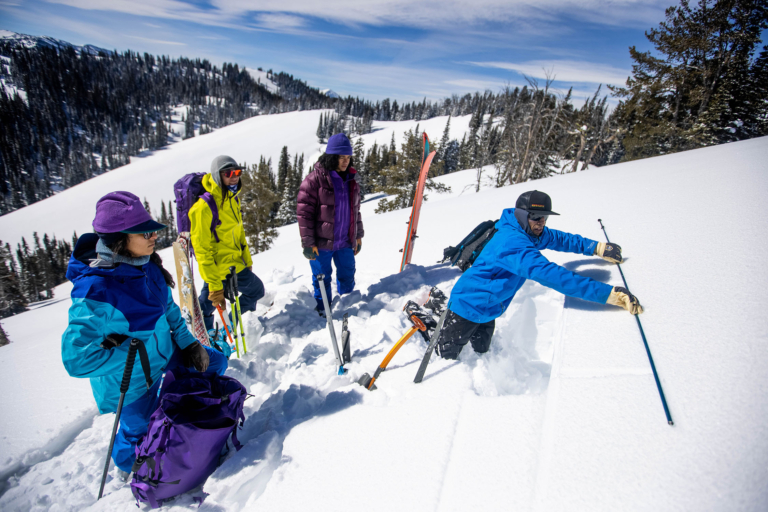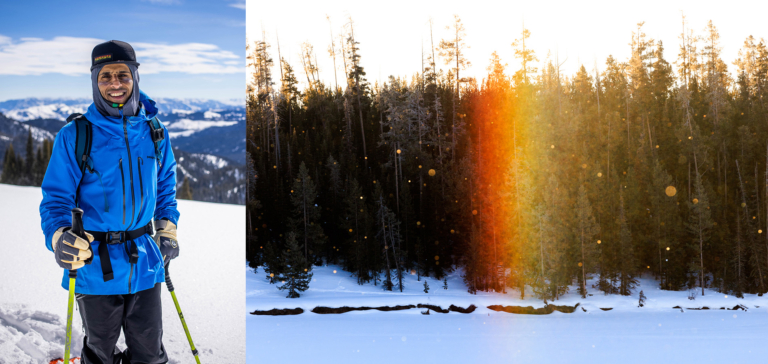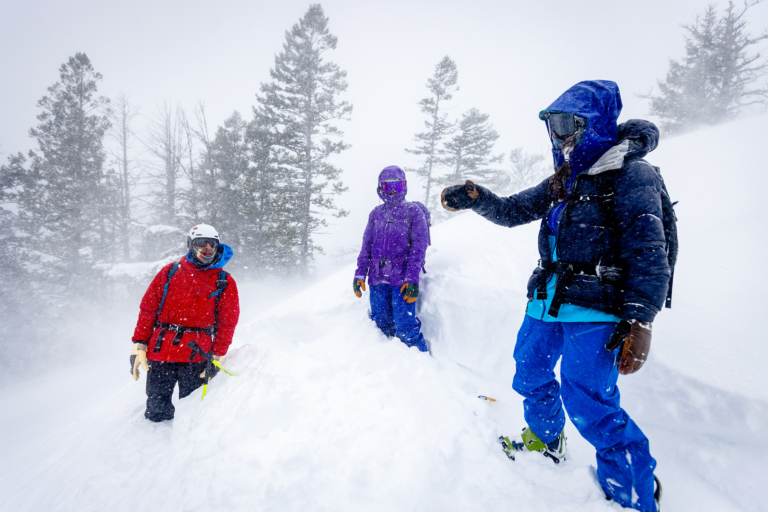Being Home
A band of mountain friends learns that when they give attention to what they see, trust and confidence can follow graciously.
All photos by Sofia Jaramillo
“There is no way we are going,” Sofia’s text read. The glow of my iPhone at once illuminated my groggy face and confirmed my own doubts about the coming excursion.
It was day two of a three-day backcountry snow safety course, and our group, an all-female crew of color learning from the legendary mountain guide Zahan Billimoria, had planned to meet at Coal Creek for our 8 a.m. start. The first day of the course had been magic; if the sight of an all-female group of color touring across a slope is something of a unicorn in the backcountry, with Zahan in tow we became Pegasus. But today would be a disappointment, I was sure of it. It was February 2021, and it had been an incredibly snowy month, one of the top five snowiest on record for Jackson, Wyoming. After a night of gusty winds and new accumulation, the Bridger-Teton Avalanche Center had increased the danger rating from “Considerable” to “High” for elevations between 7,500 and 10,500 feet. During my decade of riding in the Tetons, I could count on one hand the times that I had set out for a big objective on a “High” avalanche danger day. Hell, maybe even one finger. I locked my phone and stared at the dawn light creeping across my ceiling; we were not going up Mount Taylor.
Little did I know that that day would be the best of the course, cementing Zahan’s teaching and imparting in all of us a confidence and leadership ability that often escapes women in the backcountry. As Zahan would later tell me: “We talk about how overconfidence is such a hazard and how it can lead to bad decisions. But I think we don’t talk about confidence being essential for decision-making.”

Sheena Dhamsania, Dani Reyes-Acosta and Zynobia (left to right) watch intently as Zahan Billimoria digs to expose a deep, persistent weak layer during a three-day backcountry snow safety course. Teton Range, Wyoming.
The plan was to meet at Coal Creek and assess the conditions there. I drove into the cloudy morning, stopping to get pastries for our crew. We circled up and I dished out the goods: chocolate croissant for Sheena Dhamsania, an Indian snowboarder and composer who soon after this would trade the mountains for a river house along the Mississippi; kouign-amann for Sofia Jaramillo, a Colombian American adventure photographer always armed with Pulparindos in her jacket pockets; ham and cheese croissant for Dani Reyes-Acosta, a bright-eyed Mestiza storyteller with a laugh that could trigger an avalanche. We circled up around Zahan, who was patiently waiting for us to deliver our morning reports.
“Five a.m. temp was 3 degrees, max temp was 9 degrees,” said Dani, cutting through the drifting lattice of snowflakes.
“The average wind speed was 24 mph, winds came from a west-southwesterly direction,” followed Sheena. The gist of it was that it was cold and windy, visibility was bad and would likely get worse; I was bundled up like the Michelin Man in my down jacket, proof that it was far from bluebird.

“What I presumed coming into this course, like many times before, was that I would take a back seat, listen, be told and be led. “Z” flipped that experience on its head and created opportunities for us to take up space, to practice the proof of our utility,” Zynobia said. Dhamsania, Zynobia and Billimoria follow as Reyes-Acosta leads the group up the mountain.
On we went, each of us taking turns relaying the information to Zahan as he nodded in acknowledgement. Zahan is that rare breed of modest mountain expert; he has decades of experience navigating avalanche terrain, and yet no matter your skill level, your input is accepted without judgment. When in the field with Z, it is not just that all are welcome at the table—all are required. Unlike some of my past guided experiences, with him there was never any posturing or condescension. Though in this moment he was still largely unfamiliar to me, later I would come to realize that beyond his calm, measured demeanor, Z also has a playful side that comes out in his penchant for sweets, mixed martial arts analogies and reggae.
That morning though, he was all business.

Billimoria’s grin is almost as bright as this rainbow that appeared on an early morning ski across Jackson Lake in Grand Teton National Park.
The day earlier—our first field day—Zahan had asked us what would become the defining phrase of the course: “What do you see?” Initially each of us had struggled to put what was right in front of our eyes into words, thinking that such banal descriptions of trees, snow and sky were far too underwhelming to satisfy his adept mind. Did he really just want to be told that no snow was resting on the branches of the trees around us, that the sun was shining without a cloud in the sky, or that our poles poking along the skintrack indicated a crust just beneath the surface?
Zahan believes everything begins with observation. “It’s how we build competence in the team. Everybody has a voice. Everybody gets to notice things.” Coming from an ecological background, I see how Z’s naturalist-infused approach centers on exploring connections and following our curiosity. Without strong observational habits, we cannot begin to interpret the world around us. “Believe in what you see,” he says.
When it comes to the mountains, boldness and confidence were never close associates of mine. I never made space for myself at the table, happy to let others make the important decisions; I can’t say whether it’s nature or nurture, or maybe a blend of both. Regardless of the number of backcountry and avalanche courses I took to combat that feeling, I never left them with the confidence to take on decision-making in the mountains.
In my experience, the number one disparity in the backcountry between female identifying groups and male identifying groups is decisiveness. “I think …” “What do you think …” “Maybe …” “I don’t know …” These are all phrases and words I have heard women toss like hot potatoes. We get used to deferring to and being led by the mirage of confidence. That is not to say this is the case for everyone, but we women tend to doubt ourselves, and by extension fail to trust and name what is in front of our very own eyes. Throw other sociological variables on top and you get a spectrum of confidence on which we all fall. For me, the toppings were my skin color, gender, size and the internalized societal assumptions about me that culminated in my lived experience. I’ve written before about being Black in the mountains, and how it feels to be surrounded by a sea of white, both literally in the snowscape, but more so in the pervasive whiteness of mountain communities.
Helping people get beyond a lack of confidence to trust their observations is folded into Z’s purpose. For him, it is vital that a generation of wilderness travelers feel like “they are enough and that they belong.” This outlook is underpinned by his conviction that we are a species, like any other species on the planet, that evolved to thrive in the natural world. This informs Z’s efforts to restore confidence in our innate cognitive abilities by navigating risk in complex terrain, which hopefully gets us “back to a place of remembering that as human beings we belong outside.”
Accompanied by a band of fellow mountain women and learning from someone like Z had taught us more than how to read a slope angle and look out for weak points in the snowpack: We learned to trust our instincts and intuition.

Billimoria (left) and Zynobia (center) try to listen over howling wind as Dhamsania (right) points out the best route down the mountain. Teton Range, Wyoming.
This trust was the mentality we tried to hold onto that cold morning in the Coal Creek parking lot.
As a group we named the problems we would face ascending Mount Taylor: cliff exposure along the route, pockets of wind slab, declining visibility. We leaned into our instincts, with Zahan guiding our conversation, asking us to label the specific terrain and snowpack risks and what we could do to manage them. As we envisioned each risk variable and placed it in a mitigatable context, we became more relaxed at the possibility of continuing to our objective. We had all the knowledge we needed to have a safe day. We could not control the snowpack, but we could control where we traveled and what terrain we chose.
After evaluating the risk, we decided together to go.
As we pushed up Mount Taylor into the biting wind, Zahan sporadically prompted us to think critically about the signs and signals occurring in real-time. We asked questions and Z pushed us to answer them for ourselves. With each exchange our confidence grew in our abilities to manage the risks. As the existing skintrack began to take on a more vertical and arduous angle, Sheena picked a new path, a trail better suited to conserving our energy. The feeling of stepping off a skintrack and charting a new route up a mountain is akin to jumping into the open ocean: There is a certain fear about what lies underneath, but also liberty and freedom. With the fear comes an invitation to trust yourself.
As we began to ascend higher into the alpine, the elements intensified: harsh winds piled up wind slabs; my curls turned into frost-encased cocoons; the visibility we enjoyed earlier became a dangerous flat white. The mountain slope became difficult to discern. We still had another 500 vertical feet to the summit—close enough that it was within reach, far enough that it would take not insignificant time to reach. As we crested a saddle, there was a perceptible shift in the group’s energy. We began noticing a change in the snow beneath our skis. As I kicked and slid each ski forward into the untouched snow, dry cracks shot forth like lightning bolts from the tips of my skis. Not in immediate avalanche danger, but the ingredients for one were there.
“Hey, Sheena, should we keep going up?” I yelled over the wind’s whistle, snow swirling around us like ancient spirits as the five of us paused to consider. We pulled off into a flatter section and huddled together to chat. Did it make sense to keep going? We came around the table together, everyone pulling their metaphorical chair closer, putting the risks out there for all to see. Visibility: The flat white made us feel like we were inside of a ping-pong ball. Terrain: We were entering a steep portion that would take us to the summit.
Together, we decided that it was time to turn around. Z smiled, adding little to the conversation aside from his tacit approval of our decision-making protocol. We picked low-risk terrain to leapfrog down, full of play, delighting in weightlessness. The balance between risk and reward, between staying home and going out, between continuing to the summit or turning back, that’s what Z’s teaching focused on. In this liminal space we find what modern society has divorced us from; we find home, we find belonging and we find confidence in ourselves.

Zynobia shreds. Here in this photo and always. Enjoying some fresh snow during a snow safety course is always a bonus. Teton Range, Wyoming.
A year later, Sofia and I are venturing into the northern end of Grand Teton National Park. We are touring across a frozen Jackson Lake encased in an otherworldly thick morning fog. “It’s like we are on another planet or in the Arctic,” Sofia says. From time to time a clear line of sight of the face we plan to ride emerges. The lessons from Z’s course have stuck with us, etched themselves into our decision-making models. We are on our own, decisions and consequences wholly ours to manage, and that space feels good. As we crest the ridge, leaving behind a slippery skintrack, an older couple materializes out of thin air behind us. The kind of rugged couple that exudes an air of competence and ease that only years of dedication to the mountains can provide. We chat with them for some time about their bygone years in the park, the modifications they’ve made to their gear and so on. Before we go our separate ways, they say, “By the way, that’s a hell of a good skintrack you set back there.” Sofia and I lock eyes and smile in acknowledgement. And so, we continue upward.

Left: Zynobia and a friend skin up a ridge in the Tetons on a snowy afternoon.
Right: Zynobia moves through a burned area in Grand Teton National Park.

